1. Early Life and Amateur Career
1.1. Childhood and Education
Barry Lamar Bonds was born on July 24, 1964, in Riverside, California, to Patricia (née Howard) and Bobby Bonds, who would later become a major league player. He grew up in San Carlos, California, and attended Junípero Serra High School in San Mateo, California. At Serra, Bonds excelled in baseball, basketball, and football. He played on the junior varsity team during his freshman year before joining the varsity team for his remaining three years, from 1980 to 1982. During his senior year, he achieved an impressive .467 batting average and was recognized as a prep All-American. In the 1982 Major League Baseball draft, the San Francisco Giants selected Bonds in the second round, 39th overall. However, Bonds and the Giants could not agree on contract terms, as the Giants offered a maximum of $70.00 K USD while Bonds sought at least $75.00 K USD. Consequently, Bonds opted to attend college.
1.2. College Career
Bonds attended Arizona State University, where he continued to showcase his baseball talent. Over three years, he hit .347 with 45 home runs and 175 runs batted in (RBI). In 1984, he batted .360 and stole 30 bases. The following year, in 1985, he hit 23 home runs, recorded 66 RBI, and maintained a .368 batting average, earning him a Sporting News All-American selection. He was named to the College All-Star team for three consecutive years. As a sophomore, Bonds tied an NCAA record by achieving seven consecutive hits in the College World Series, and in 1996, he was named to the All-Time College World Series Team. He graduated from Arizona State in 1986 with a degree in criminology. Bonds also received the ASU On Deck Circle Most Valuable Player award, an honor shared by notable players such as Dustin Pedroia, Willie Bloomquist, Paul Lo Duca, and Ike Davis. During one summer in college, he played for the Alaska Goldpanners of Fairbanks in the amateur Alaska Baseball League, which is considered to have a level of play very close to minor league baseball.
Despite his on-field success, Bonds was not well-liked by his Arizona State teammates. According to longtime coach Jim Brock, he was perceived as "rude, inconsiderate and self-centered." When he was once suspended for breaking curfew, his teammates initially voted against his return, even though he was undeniably the best player on the team.
1.3. Draft and Minor Leagues
After his collegiate career, the Pittsburgh Pirates drafted Bonds with the sixth overall pick in the 1985 Major League Baseball draft. He joined the Prince William Pirates of the Carolina League, where he was named the league's Player of the Month for July 1985, hitting .299 with 13 home runs. In 1986, he continued to impress in Triple-A with the Hawaii Islanders of the Pacific Coast League, batting .311 with seven home runs and a .435 on-base percentage in 44 games before being called up to the major leagues.
2. Professional Career
Barry Bonds's professional baseball career spanned 22 seasons, during which he played for the Pittsburgh Pirates and the San Francisco Giants, achieving unprecedented statistical milestones and transforming the game with his offensive prowess.
2.1. Pittsburgh Pirates (1986-1992)
Bonds made his major league debut on May 30, 1986, for the Pittsburgh Pirates, starting as the leadoff hitter and center fielder in a 6-4 loss to the Los Angeles Dodgers. He went 0-for-5 with a walk against Orel Hershiser. On June 4, he hit his first major league home run and drove in four runs, contributing to a 12-3 victory over the Atlanta Braves. In his rookie year, Bonds led all National League rookies with 16 home runs, 48 RBI, 36 stolen bases, and 65 walks, despite finishing with a career-worst .223 batting average and 102 strikeouts. He placed sixth in the Rookie of the Year voting. In 1987, with the arrival of Andy Van Slyke, Bonds shifted to left field, a position he would primarily play throughout his career.
Before Bonds's arrival, the Pirates faced low fan attendance, with games in 1984 and 1985 averaging fewer than 10,000 spectators due to economic problems in Western Pennsylvania and the Pittsburgh drug trials that had impacted the team. Bonds's presence helped spark a surge in fan enthusiasm, with the team setting a club attendance record of 52,119 at the 1987 home opener. Bonds and Van Slyke formed a formidable defensive tandem in the outfield, covering significant ground, though their relationship off the field was not close. In 1987, Bonds hit .261 with 25 home runs, 59 RBI, and 32 stolen bases in 150 games.
He continued to improve in 1988, batting .283 with 24 home runs and 58 RBI in 144 games. The Pirates broke their own attendance record with 54,089 at the home opener, now featuring a highly respected lineup including Bonds, Bobby Bonilla, Van Slyke, and Jay Bell. In 1989, Bonds hit 19 home runs, recorded 58 RBI, and finished second in the NL with 14 outfield assists, despite a dip in his batting average to .248. Rumors of a trade to the Dodgers for Jeff Hamilton and John Wetteland circulated but were denied by the Pirates and never materialized.
In 1990, Bonds had a standout season, winning his first MVP Award. He batted .301 with 33 home runs and 114 RBI in 151 games. He also stole 52 bases, which was third in the league, becoming the second player in history to join the 30-30 club (30 home runs and 30 stolen bases) and the 20-50 club (20 home runs and 50 stolen bases). He also earned his first Gold Glove Award and Silver Slugger Award. That year, the Pirates secured the National League East title, their first postseason berth since winning the 1979 World Series. However, they were defeated by the Cincinnati Reds in the NLCS, who went on to win the 1990 World Series.
Bonds maintained his high level of play in 1991, batting .292 with 25 home runs and 116 RBI in 153 games, earning another Gold Glove and Silver Slugger. He finished second in MVP voting to Terry Pendleton of the Atlanta Braves. The Pirates again won the NL East but lost to the Braves in the NLCS. In March 1992, Pirates general manager Ted Simmons agreed to trade Bonds to the Braves for Alejandro Peña, Keith Mitchell, and a player to be named later. However, Pirates manager Jim Leyland vehemently opposed the trade, and it was rescinded.
Bonds remained with Pittsburgh and won his second MVP award in 1992, hitting .311 with 34 home runs and 103 RBI, while stealing 39 bases, achieving his second career 30-30 season. He also led the league with 109 runs scored and 127 walks, along with a .456 on-base percentage and a .624 slugging percentage, and a 1.080 OPS. He propelled the Pirates to their third consecutive NL East division title. For the third straight year, the Pirates were denied a trip to the World Series, losing to the Braves in a seven-game NLCS. In the decisive Game 7, Bonds fielded a base hit by Francisco Cabrera and attempted to throw out Sid Bream at home plate, but the throw was late, allowing Bream to score the winning run. Following the loss, it was widely anticipated that Bonds and teammate Doug Drabek would command salaries too high for Pittsburgh to retain them, leading to Bonds's departure. Despite his MVP awards, Bonds was generally unpopular with reporters and fans in Pittsburgh; one paper even gave him an "award" as the "MDP" (Most Despised Pirate).
2.2. San Francisco Giants (1993-2007)
With the San Francisco Giants, Bonds further solidified his legendary status through a period of dominant all-around play, followed by a record-breaking offensive peak in the early 2000s, culminating in his pursuit and breaking of the all-time home run record before his retirement.
2.2.1. Early Giants Years and All-Around Play (1993-1999)
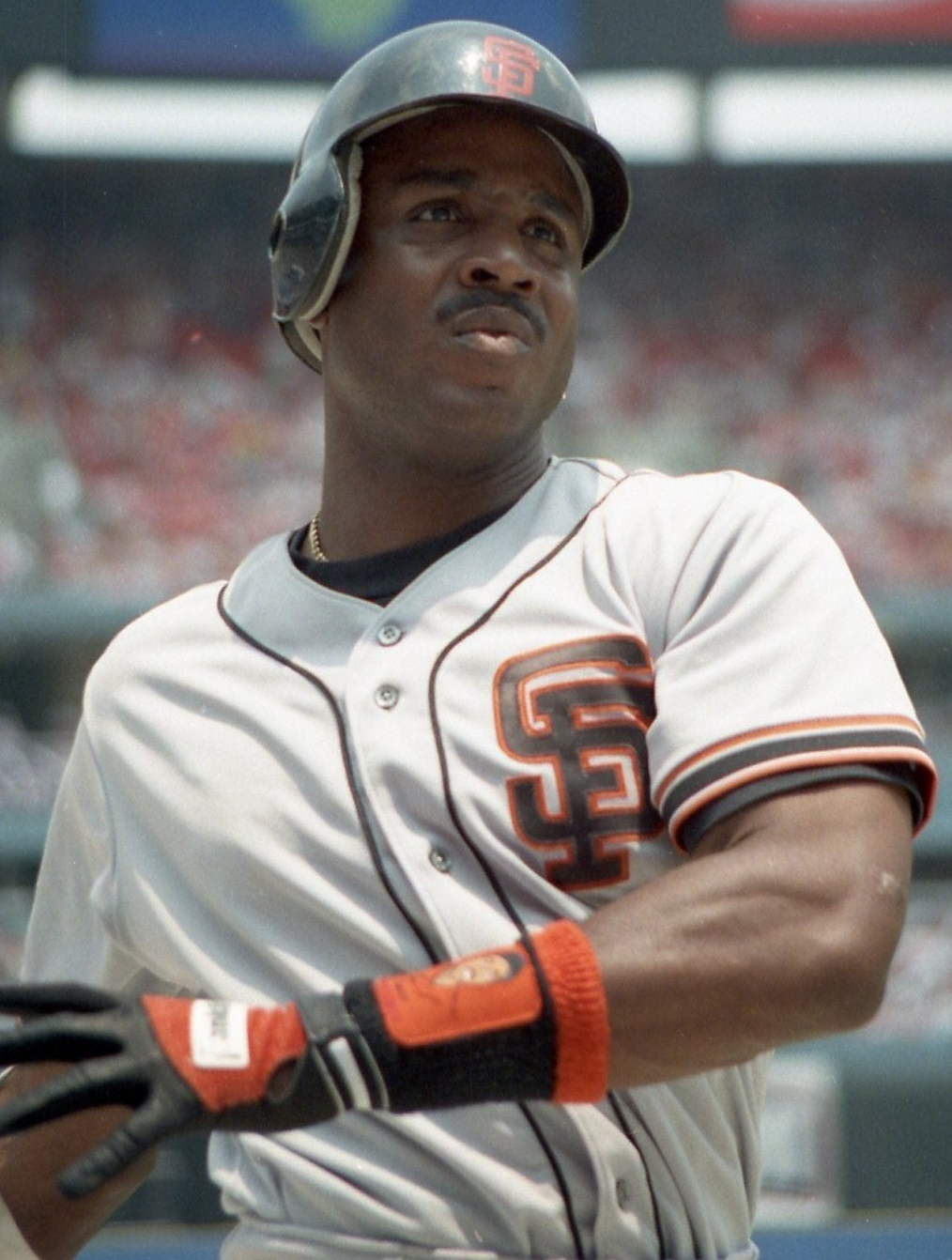
In 1993, Bonds left the Pirates to sign a lucrative six-year, $43.75 M USD free agent contract with the San Francisco Giants, the team his father Bobby Bonds had played for and where his godfather Willie Mays spent most of his career. This deal was the largest in baseball history at the time, both in total value and average annual salary. Bonds initially intended to wear his customary number 24, the same number worn by Mays, who had retired it. Although Mays gave his blessing, public outcry from fans and media prevented Bonds from using it. To honor his father, Bonds chose to wear number 25, which Bobby had worn in San Francisco.
In an emotional press conference, Bonds described joining the Giants as "going home" and fulfilling a "boyhood dream." His father also joined the team as a coach that year. During a game on May 12, 1993, against the Colorado Rockies, both Bonds and his father were ejected for their involvement in an on-field fight.
In 1993, Bonds hit .336, leading the NL with 46 home runs and 123 RBI in 159 games, earning his second consecutive MVP award and third overall. He also led the league in on-base percentage (.458), slugging percentage (.677), and OPS (1.136). The Giants won 103 games, but the Atlanta Braves won 104, making it one of the last great pennant races before the wild card was introduced. Bonds's performance, including 45 home runs and 25 stolen bases, put him in an elite group of players.
In the strike-shortened 1994 season, Bonds hit .312 with 37 home runs, 81 RBI, and a league-leading 74 walks in 112 games. He finished fourth in MVP voting. That same year, he made a small acting appearance as himself in the television film Jane's House.
In 1995, Bonds played in all 144 games, hitting .294 with 33 home runs, 104 RBI, and 31 stolen bases, marking his third 30-30 season. He also led the league with 120 walks and a 1.009 OPS.
In 1996, Bonds made history by becoming the first National League player and second major league player (after José Canseco in 1988) to hit 40 home runs and steal 40 bases in the same season, joining the exclusive 40-40 club. Other members include Alex Rodriguez (1998), Alfonso Soriano (2006), Ronald Acuña Jr. (2023), and Shohei Ohtani (2024). His father, Bobby Bonds, had narrowly missed this feat in 1973 with 39 home runs and 43 stolen bases. On April 27, Bonds hit his 300th career home run off John Burkett of the Florida Marlins, becoming the fourth player (after Willie Mays, Andre Dawson, and his father) to reach the 300 home run/300 stolen base club. He finished the season with 129 RBI, a .308 average, and a then-National League record 151 walks. He placed fifth in the MVP balloting.
In 1997, Bonds hit 40 home runs for the second consecutive year and drove in 101 runs, again leading the league with 145 walks. He also stole 37 bases, tying his father with five 30-30 seasons, and once again finished fifth in MVP voting. Despite this, the Giants lost their Division Series to the Marlins in three games.
On May 28, 1998, with two outs in the ninth inning of a game against the Arizona Diamondbacks, Bonds became only the fifth player in baseball history to be given an intentional walk with the bases loaded. This rare occurrence had only been done by Nap Lajoie (1901), Del Bissonette (1928), Bill Nicholson (1944), and Abner Dalrymple (1881). On August 23, Bonds hit his 400th career home run off Kirt Ojala, also of the Marlins, becoming the first and only player to enter the 400 home run/400 stolen base club. For the season, he hit .303 with 37 home runs and 122 RBI, winning his eighth Gold Glove. He finished eighth in MVP voting.
The 1999 season marked a career-low in playing time for Bonds due to injuries. He started strong, batting .366 with four home runs and 12 RBI in the first 12 games of April. However, a torn bicep tendon and bone spurs in his elbow required surgery, sidelining him for the rest of April and all of May. Upon his return in June, he struggled with nagging injuries, including elbow pain, knee inflammation, and groin issues, hitting only .248 after coming off the disabled list. Despite missing nearly two full months and playing only 102 games, he managed to hit 34 home runs, drive in 83 runs, and post a .617 slugging percentage.
Bill James, the founder of sabermetrics, ranked Bonds as the best player of the 1990s, stating that the decade's second-best player, Craig Biggio, was closer in production to the 10th-best player than to Bonds. In 1999, based on statistics through 1997, Bonds was ranked 34th on The Sporting News' list of the 100 Greatest Baseball Players, making him the highest-ranking active player. When the list was redone in 2005, Bonds was ranked 6th, behind Babe Ruth, Willie Mays, Ty Cobb, Walter Johnson, and Hank Aaron. Despite his immense talent, Bonds was controversially omitted from the 1999 Major League Baseball All-Century Team, with Ken Griffey Jr. being the only active player elected. James notably wrote of Bonds, "Certainly the most unappreciated superstar of my lifetime. ... Griffey has always been more popular, but Bonds has been a far, far greater player." He predicted that when Bonds's accomplishments were fully considered, he might be rated among the five greatest players in the history of the game.
2.2.2. Record-Breaking Offensive Peak (2000-2004)
In 2000, Bonds hit .306 with career bests in slugging percentage (.688) and home runs (49) in just 143 games, also drawing a league-leading 117 walks. His offensive production escalated even further in 2001, breaking personal and major league records. In the Giants' first 50 games in 2001, he hit 28 home runs, including 17 in May, a career high. This impressive start included his 500th home run, hit on April 17 against Terry Adams of the Los Angeles Dodgers. He also hit 39 home runs by the All-Star break, a major league record. Bonds finished the season with a major league record 73 home runs, shattering Mark McGwire's previous record of 70, set in 1998. He achieved this milestone by homering off Wilfredo Rodríguez on October 4 for his 70th, followed by numbers 71 and 72 the next night off Chan Ho Park, and his 73rd off Dennis Springer on October 7. The 73rd home run ball was later sold to toy manufacturer Todd McFarlane for $450.00 K USD. Bonds also drew a major league record 177 walks and achieved a .515 on-base average, a feat not seen since Mickey Mantle and Ted Williams over 40 years prior. His slugging percentage was a major league record .863 (411 total bases in 476 at-bats). Bonds received the Babe Ruth Home Run Award for leading MLB in home runs that season, and despite the team missing the playoffs, he won his fourth MVP award, an unprecedented achievement. During this period, Bonds's dramatically changed physique and sudden power surge fueled widespread speculation about performance-enhancing drug use, though he maintained his innocence.
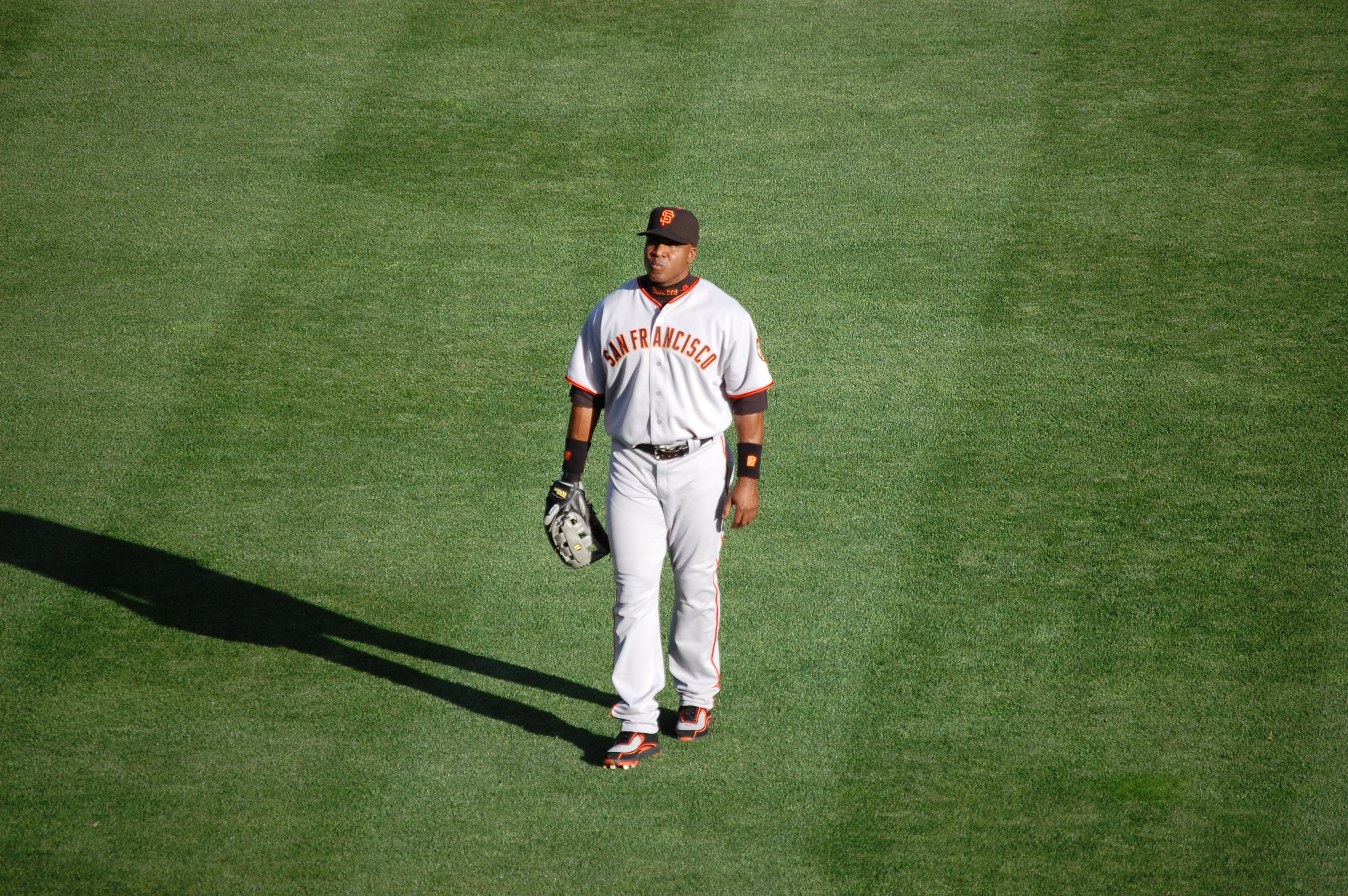
Bonds re-signed with the Giants for a five-year, $90.00 M USD contract on January 15, 2002. He started the season by hitting five home runs in the Giants' first four games, tying Lou Brock's 35-year record. He won the NL batting title with a career-high .370 average and also recorded 46 home runs, 110 RBI, and just 47 strikeouts in 403 at-bats. Despite playing nine fewer games than the previous season, he drew a major league record 198 walks, 68 of which were intentional walks, surpassing Willie McCovey's 45 in 1969 for another MLB record. His slugging percentage of .799 was then the fourth-highest all time, and he broke Ted Williams' major league record for on-base average with .582. Bonds also hit his 600th home run on August 9 against Kip Wells of the Pirates, less than a year and a half after hitting his 500th. The Giants reached the 2002 World Series, but lost in seven games to the Anaheim Angels, despite Bonds batting .322 with eight home runs, 16 RBI, and 27 walks in the postseason.
In 2003, Bonds played in 130 games, hitting 45 home runs in just 390 at-bats, along with a .341 batting average. He slugged .749, walked 148 times, and had an on-base average well over .500 (.529) for the third consecutive year. On June 23, he became the only member of the career 500 home run/500 stolen base club by stealing second base off pitcher Éric Gagné in the 11th inning of a tied game against the Los Angeles Dodgers. Bonds later scored the game-winning run in that inning. This milestone underscored his unique combination of power and speed, a feat unmatched by any other player.
In 2004, Bonds had perhaps his most dominant season at the plate. He hit .362 en route to his second National League batting title and shattered his own record by drawing 232 walks, including an MLB record 120 intentional walks. He slugged .812, which was fourth-highest all time, and broke his on-base percentage record with an astonishing .609 average. Bonds passed Mays on the career home run list by hitting his 661st off of Ben Ford on April 13. He then hit his 700th career home run off of Jake Peavy on September 17. Bonds hit 45 home runs in only 373 at-bats and struck out just 41 times, placing himself in an elite category of players who have had more home runs than strikeouts in a season. Bonds won his fourth consecutive MVP award, and seventh overall, marking four more than any other player in history. No other player from either league has been awarded the MVP four times in a row. At 40 years old, he also broke Willie Stargell's 25-year record as the oldest player to win an MVP award. On July 4, he tied and passed Rickey Henderson's career bases on balls record with his 2,190th and 2,191st career walks.
As Bonds approached Hank Aaron's career home run record, Aaron stated he was a fan and admirer of Bonds, and he avoided the controversy regarding Bonds's alleged steroid usage. Aaron felt that the recognition and respect for the record should be determined by the fans. However, as the steroid controversy intensified before the 2005 season, Aaron expressed reservations about Bonds's statements on the issue, emphasizing that drug and steroid use to boost athletic performance was inappropriate. Aaron grew frustrated that the media could not focus on on-field events and wished drug or gambling allegations could be de-emphasized. In 2007, Aaron decided he would not attend any potential record-breaking games. He later congratulated Bonds through the media, including a video played on the scoreboard when Bonds eventually broke Aaron's record in August 2007.
2.2.3. Final Seasons and All-Time Home Run Record (2005-2007)
Bonds's salary for the 2005 season was $22.00 M USD, the second-highest in Major League Baseball. He endured a knee injury and multiple surgeries, limiting him to just 14 games. He returned on September 12, hitting .286 with five homers and 10 RBI, including home runs in four consecutive games from September 18 to 21. This unexpected injury contributed to the Giants' first losing season since 1996.
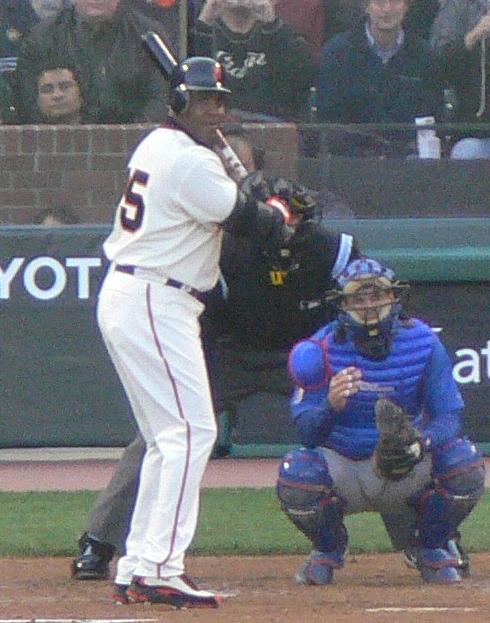
In 2006, Bonds earned $20.00 M USD, making him baseball's all-time highest-paid player with approximately $172.00 M USD earned over his 21-year career. He started the season slowly, not hitting a home run until April 22, his longest slump since 1998. On May 7, he hit his 713th career home run off Jon Lieber into the second level of Citizens Bank Park in Philadelphia, drawing within one of tying Babe Ruth for second place on the all-time list. This towering home run traveled an estimated 450 ft, one of the longest in the park's history. On May 20, Bonds tied Ruth with his 714th career home run off Brad Halsey of the Oakland Athletics in an interleague game in Oakland. Bonds was quoted afterward as being "glad it's over with."
On May 28, 2006, Bonds surpassed Ruth, hitting his 715th career home run to center field off Colorado Rockies pitcher Byung-hyun Kim. The ball traveled an estimated 445 ft before being caught by Andrew Morbitzer, a San Francisco resident, near a concession stand. Mysteriously, the radio play-by-play went silent as the ball was hit, though the televised broadcast was unaffected.
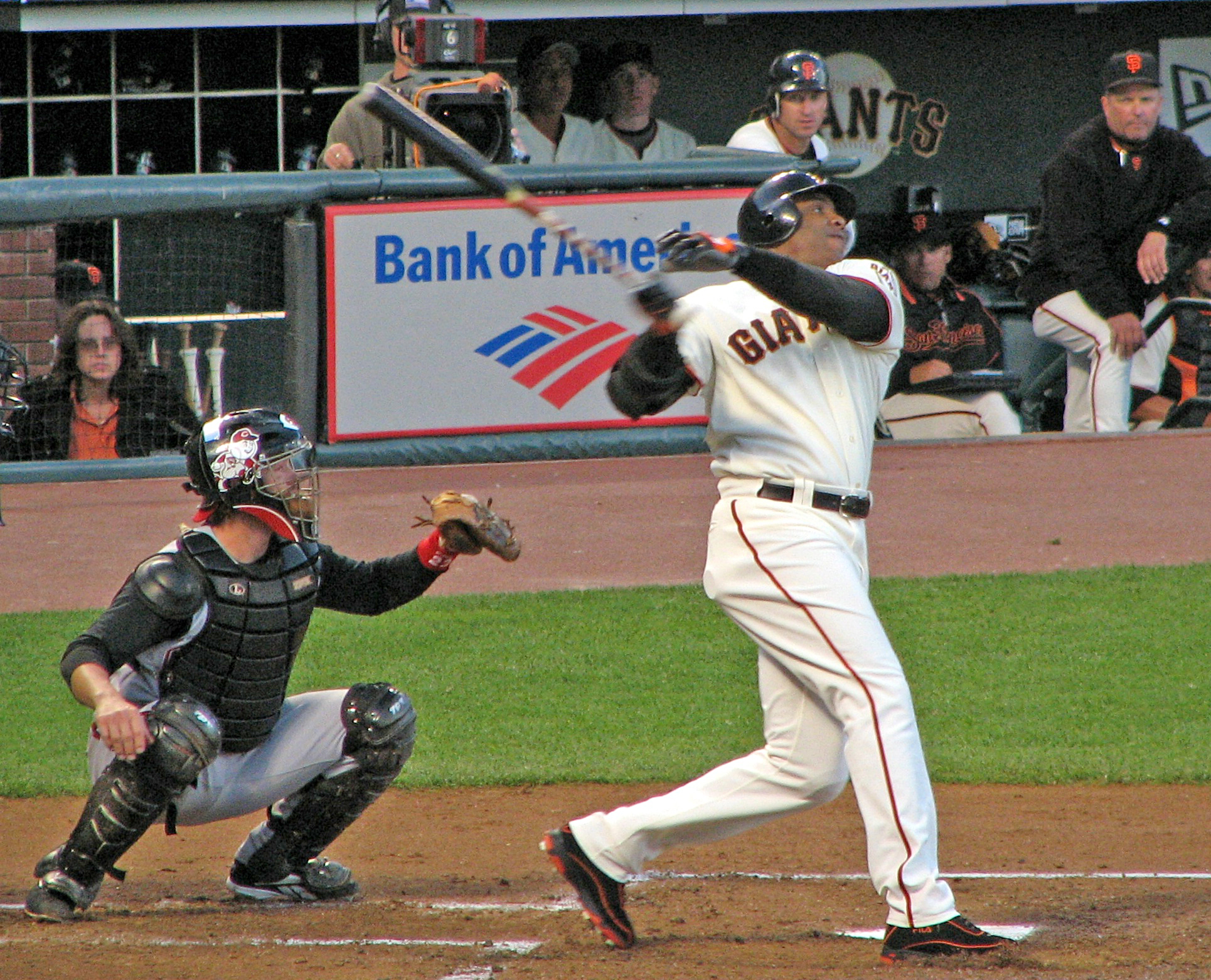
On September 22, Bonds tied Henry Aaron's National League career home run record of 733 against the Milwaukee Brewers at Miller Park in Milwaukee, Wisconsin. This achievement was particularly notable as it occurred in the city where Aaron began and concluded his career. On September 23, Bonds surpassed Aaron for the NL career home run record, hitting his 734th solo home run off Chris Capuano, also in Milwaukee. In 2006, Bonds recorded his lowest slugging percentage since 1991, but still led the league in walks (115) and intentional walks (38).
In January 2007, the New York Daily News reported that Bonds had tested positive for amphetamines. Under baseball's then-new amphetamine policy, a first positive test typically resulted in additional testing, treatment, and counseling, with no public identification. However, the New York Daily News leaked the results. Bonds initially attributed the positive test to a substance taken from teammate Mark Sweeney's locker but later retracted the claim and publicly apologized to Sweeney.
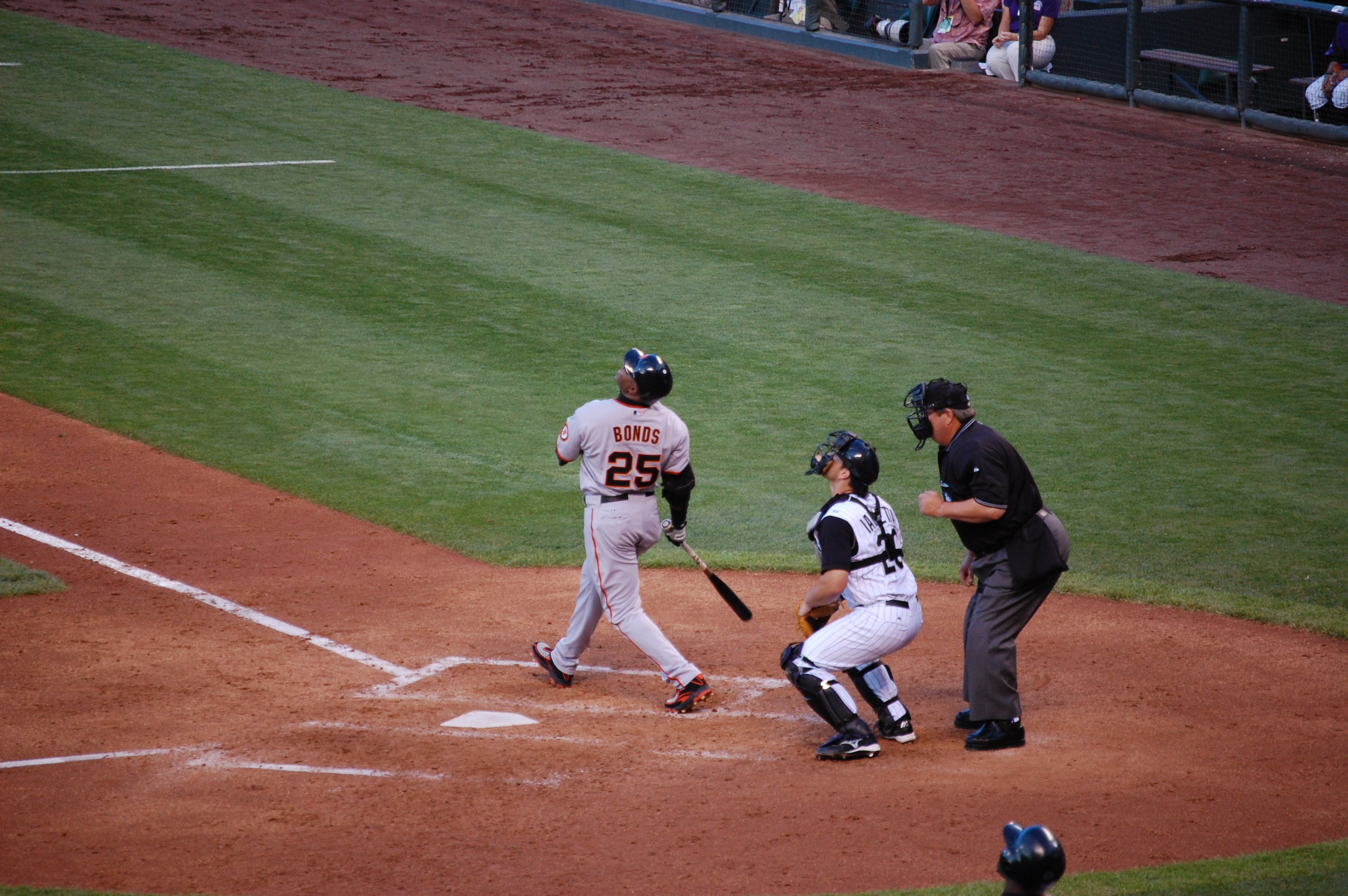
On January 29, 2007, the Giants finalized a contract with Bonds for the 2007 season, a one-year, $15.80 M USD deal that was revised and signed on February 15. Bonds resumed his pursuit of the all-time home run record early in the season. In the season opener on April 3, he had a single and a stolen base but was thrown out at home. The next day, on April 4, he hit his 735th career home run off Chris Young of the San Diego Padres at AT&T Park, pushing him past the midpoint between Ruth and Aaron. He continued his ascent, hitting two home runs (736 and 737) on April 13 against the Pirates, and his 738th into McCovey Cove on April 18 off Ryan Franklin of the St. Louis Cardinals.
The hype surrounding Bonds's pursuit intensified on May 14, when a Dallas-based auction house offered $1.00 M USD to the fan who would catch his 756th home run ball, an offer later rescinded on June 11 due to safety concerns. On Father's Day, June 17, Bonds hit his 748th home run at Fenway Park against the Boston Red Sox, making it the 36th major league ballpark in which he had homered. This was his first home run off former Pirates teammate Tim Wakefield, who became the 441st different pitcher to surrender a four-bagger to Bonds. His 750th career home run came on June 29 off another former teammate, Liván Hernández.
On July 19, after a 21 at-bat hitless streak, Bonds hit home runs 752 and 753 against the Chicago Cubs. On July 27, he hit his 754th home run against Florida Marlins pitcher Rick VandenHurk, marking the first time since his 747th that Bonds had homered in a Giants victory. On August 4, Bonds hit home run number 755 against Clay Hensley of the San Diego Padres, tying Hank Aaron's all-time record. Bonds embraced his son, Nikolai, after crossing home plate. Ironically, the tying home run was hit off a pitcher who had been suspended by baseball in 2005 for steroid use, adding another layer to the controversy surrounding Bonds.
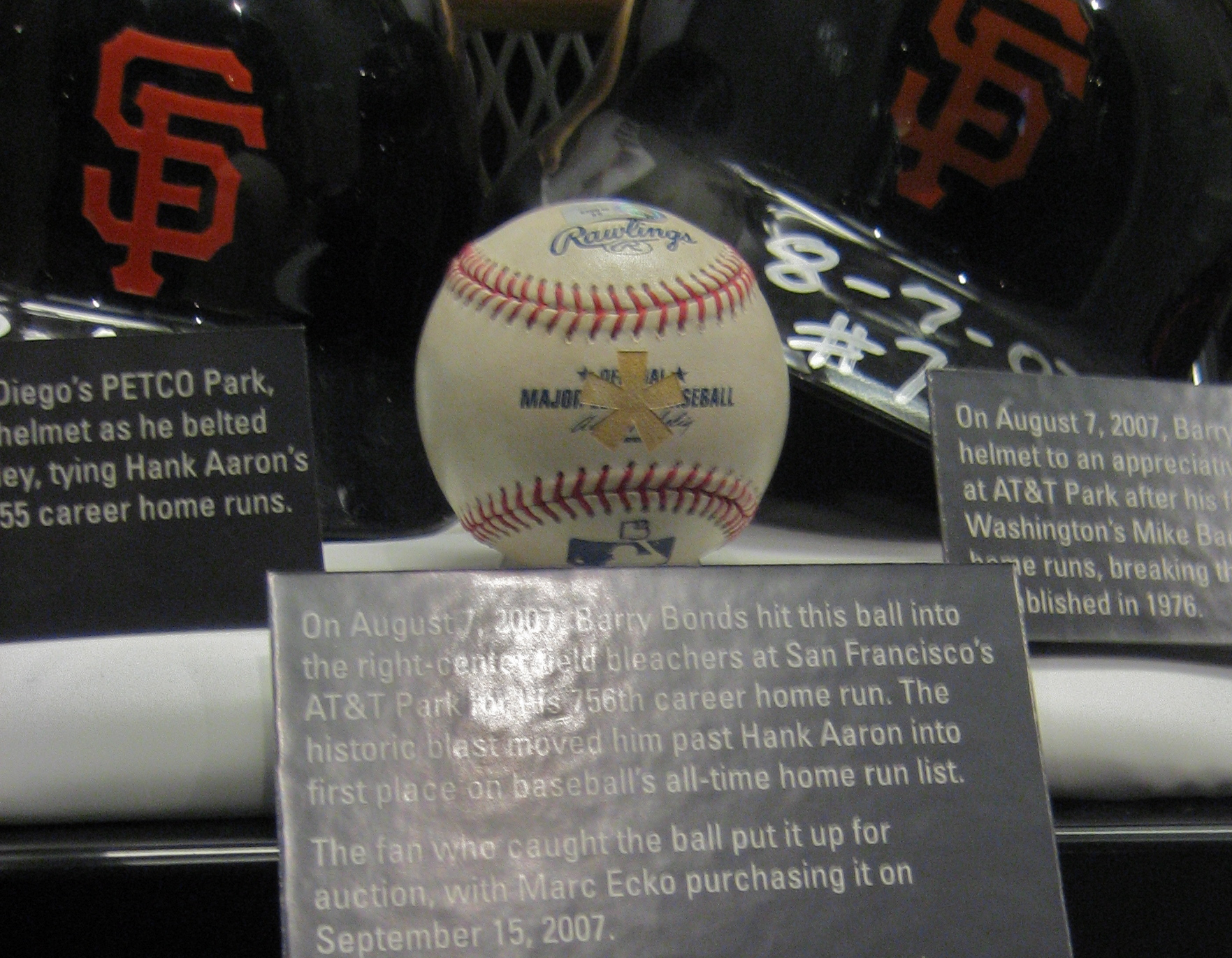
On August 7 at 8:51 PM PDT, at Oracle Park (then AT&T Park) in San Francisco, Bonds hit his 756th home run off a pitch from Mike Bacsik of the Washington Nationals, officially breaking Hank Aaron's all-time career home run record, which had stood for 33 years. Coincidentally, Bacsik's father had faced Aaron as a pitcher for the Texas Rangers after Aaron hit his 755th home run. After hitting the record-breaking home run, Bonds gave Bacsik an autographed bat.
The 3-2 pitch was hit into the right-center field bleachers, where 22-year-old Matt Murphy from Queens, New York City, caught the ball. A 10-minute delay followed, during which a video message from Hank Aaron was played on the scoreboard, congratulating Bonds and expressing hope that "the achievement of this record will inspire others to chase their own dreams." Bonds delivered an impromptu emotional statement on the field, with his godfather Willie Mays by his side, thanking his teammates, family, and his late father.
Bud Selig, the commissioner, was not in attendance but was represented by Executive Vice President of Baseball Operations Jimmie Lee Solomon. Selig called Bonds later that night to congratulate him, as did President George W. Bush the next day. On August 24, San Francisco celebrated Bonds's career achievements and record-breaking home run with a rally in Justin Herman Plaza. The event featured video messages from legends like Lou Brock, Ernie Banks, Ozzie Smith, Joe Montana, Wayne Gretzky, and Michael Jordan. Speeches were given by Willie Mays, Giants teammates Omar Vizquel and Rich Aurilia, and Giants owner Peter Magowan. Mayor Gavin Newsom presented Bonds with the key to the City and County of San Francisco, and Giants vice president Larry Baer gave Bonds the home plate he touched after hitting his 756th home run.
The record-setting 756th ball was consigned to an auction house on August 21 and sold for $752.47 K USD on September 15 after an online auction. The high bidder, fashion designer Marc Ecko, created a website where fans could decide its fate. Ten million voters decided to brand the ball with an asterisk and send it to the National Baseball Hall of Fame and Museum. Bonds commented on Ecko's decision, calling it "stupid." Ben Padnos, who bought the record-tying 755th home run ball, also sought fan input on its fate; fans voted two-to-one to smash it.
Bonds concluded the 2007 season with a .276 batting average, 28 home runs, and 66 RBI in 126 games and 340 at-bats. At 43 years old, he led both leagues in walks with 132.
3. Post-Playing Career
3.1. Baseball Involvement and Coaching
On September 21, 2007, the San Francisco Giants confirmed they would not re-sign Bonds for the 2008 season, an announcement that had been first made on Bonds's own website earlier that day. Bonds officially filed for free agency on October 29, 2007, with his agent anticipating widespread interest. However, no team signed him for the 2008 or 2009 seasons. Had he returned, Bonds would have been close to several significant milestones: needing 65 hits for 3,000, four RBI for 2,000, and 38 home runs for 800. He was also within reach of Rickey Henderson's all-time runs record (69 shy) and Hank Aaron's extra-base hits record (37 shy).
As of November 2009, Bonds's agent maintained he was not retired, but by December, he conceded that Bonds had likely played his last major league game. In April 2010, Bonds stated he was proud of Mark McGwire for admitting his steroid use and noted he wasn't in shape to play immediately. In May 2015, Bonds filed a grievance against Major League Baseball, alleging collusion to prevent him from being signed after the 2007 season, but an arbitrator ruled in favor of MLB in August 2015.
Bonds returned to the Giants organization on March 10, 2014, for a seven-day stint as a roving spring training instructor. On December 4, 2015, he was announced as the new hitting coach for the Miami Marlins but was relieved of his duties on October 3, 2016, after just one season. Bonds released a public thank-you letter to Marlins owner Jeffrey Loria, calling the opportunity "one of the most rewarding experiences of my baseball career." In 2017, Bonds officially rejoined the Giants as a special advisor to the CEO. On July 8, 2017, Bonds was added to the Giants Wall of Fame. On February 6, 2018, the Giants announced they would retire his number 25 jersey, which happened on August 11, 2018. His number 24 with the Pirates, however, remains in circulation.
3.2. National Baseball Hall of Fame Consideration
In his ten years of eligibility for the National Baseball Hall of Fame and Museum, Barry Bonds never received the 75% of votes from the Baseball Writers' Association of America (BBWAA) needed for induction. His vote percentages steadily increased from 36.2% in 2013 to 66% in 2022, his final year on the BBWAA ballot, but consistently fell short of the required threshold. Many BBWAA voters explicitly stated that they did not vote for Bonds due to their belief that he used performance-enhancing drugs.
Despite falling off the BBWAA ballot, Bonds remained eligible for consideration through the Hall of Fame's Today's Game Committee, also known as the veterans' committee. This committee, comprising 16 members of the National Baseball Hall of Fame, executives, and veteran media members, considers retired players from 1986 to 2016 who are no longer eligible for the BBWAA ballot but made notable contributions. The vote took place in December 2022; however, Bonds received fewer than four of the twelve votes required for induction, further reinforcing his exclusion from the Hall.
The debate surrounding Bonds's Hall of Fame eligibility became a central discussion, especially given the steroid era. Advocates for his induction argued that his pre-steroid statistics alone warranted his place, highlighting his long-term excellence. They also pointed out that performance-enhancing drugs were not explicitly prohibited by MLB at the time of his alleged use, and that distinguishing between "clean" and "dirty" players was difficult due to widespread doping. Furthermore, some suggested that the Hall of Fame should acknowledge all aspects of baseball's history, including its controversies, and that using steroids did not automatically grant success. Conversely, opponents of his induction argued that any proven or strongly suspected use of performance-enhancing drugs violated the integrity and sportsmanship clauses of the Hall of Fame's selection criteria, regardless of his talent or the rules at the time.
4. Controversies and Public Image
Barry Bonds's career was frequently overshadowed by significant controversies, particularly relating to his public persona, his alleged involvement in the BALCO steroid scandal, and subsequent legal proceedings. These issues shaped his reputation and enduring legacy in baseball.
4.1. Public Persona and Media Relations
Throughout his playing career, Bonds was often described as a difficult, surly, standoffish, and ungrateful individual. In a 2016 interview, he expressed regret for the public persona he had created, attributing it to the immense pressure he felt to perform as a young player with the Pirates. He stated, "Hell, I kick myself now, because I'm getting great press [since being more cooperative], and I could have had a trillion more endorsements, but that wasn't my driving force. The problem was, when I tried to give in a little bit, it never got better. I knew I was in the midst of that image, and I determined at that point that I was never going to get out of it. So I just said, 'I've created this fire around me, and I'm stuck in it, so I might as well live with the flames.'"
Bonds recounted an instance during his Giants tenure where, at the urging of teammates, he attempted to change his demeanor by smiling more and engaging pleasantly. However, during a subsequent slump, the same teammates implored him to revert to his competitive, standoffish self, believing his new attitude was detrimental to the team's performance. Bonds claimed he complied, maintaining that familiar edge for the remainder of his career.
His contentious relationship with the media was well-documented. On May 9, 1996, Bonds shoved USA Today journalist Rod Beaton in the team's clubhouse, telling him to leave despite MLB rules allowing reporters access. Beaton later stated Bonds accused him of having an "attitude" and did not apologize. Bonds, however, dismissed the incident as "a big joke." He was known for tense interviews, occasionally using profanity, and often alienating reporters, leading to predominantly negative media coverage in the United States. It was even suggested that his public image contributed to him narrowly missing the 1991 MVP award, which went to Terry Pendleton, despite Bonds's superior statistics. Bonds himself once tearfully wondered if he would only be recognized after his death. He also pointed out racial disparities in media coverage during the 1998 home run chase between Mark McGwire and Sammy Sosa, suggesting his own perceived lack of attention was due to his race.
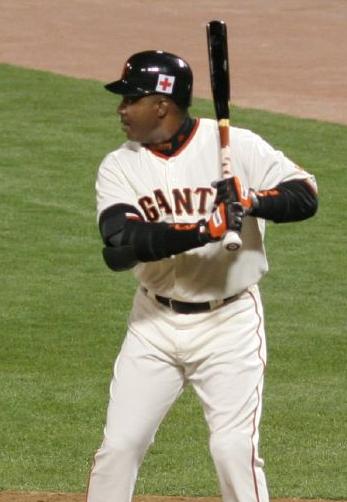
Bonds's confrontational nature dated back to his college and minor league days. He was described as rude and inconsiderate by college coaches, and minor league teammates reportedly refused to room with him due to his arrogance. Upon joining the Pirates' A-level team, he boldly introduced himself as "Barry Bonds, the first-round draft pick" to manager Ed Otto, who quickly put him in his place. Otto's strict approach, in contrast to his lenient father, eventually earned Bonds's respect. However, veteran teammates like Andy Van Slyke and Matt Williams were known to confront him over his disrespect. His feud with teammate Jeff Kent was public, culminating in a dugout altercation in 2001.
In the clubhouse, Bonds was known to occupy multiple lockers, including prime spots near the showers, and kept a personal sofa and large television. He would reportedly lash out if teammates used his sofa without permission. He famously made statements such as "a pitcher winning MVP is an insult to position players" and "I don't fundamentally acknowledge Ruth's records because he played when only white players were allowed; I am the greatest hitter in MLB history." When asked about his 500th home run by his former Pirates GM Syd Thrift, Bonds sarcastically remarked, "If you had brought me up to the majors earlier, I would have reached 500 even sooner."
Despite his often isolated standing within the team due to his arrogance, the celebration of his 756th home run was a notable exception, with the entire team, local fans, and even the opposing team celebrating his achievement. Bonds, surprisingly, also exhibited a humorous side, once joking about needing to "bunt more" when asked about chasing the home run record, and teasing rookie Fred Lewis about only hitting home runs on holidays. He also showed loyalty and compassion; after his bodyguard and friend Franklin Bradley died following obesity surgery, Bonds tearfully dedicated a home run to him, having reportedly helped fund the costly procedure for his uninsured friend.
Bonds generally maintained a more amicable relationship with Japanese media and players compared to his American counterparts. He notably communicated well with former Giants teammate Shinjo Tsuyoshi, who was reportedly the only player Bonds regularly conversed with in the clubhouse. Bonds even loaned Shinjo his mascot bat and expressed admiration for him after his retirement. He also had positive interactions with Japanese pitchers like Takashi Saito (giving him a bat) and Hideki Matsui (offering advice during a home run derby). Bonds praised Ichiro Suzuki, considering him superior to Pete Rose in hitting, and expressed admiration for Shohei Ohtani, calling him an "unparalleled talent."
4.2. BALCO Scandal

Since 2003, Bonds has been a key figure in the BALCO scandal, which involved the distribution of performance-enhancing drugs. BALCO marketed tetrahydrogestrinone ("the Clear"), an anabolic steroid undetectable by conventional doping tests. Bonds's dramatic increase in physique and power after 1998, particularly in his late 30s, fueled widespread speculation of steroid use. This period saw his weight increase from 185 lb (84 kg) at the start of his career to 240 lb (109 kg) by 2007. The belief that Bonds began using drugs after the 1998 home run race between Mark McGwire and Sammy Sosa is a common theory; his friend Ken Griffey Jr. later claimed Bonds indicated he would start using steroids after feeling overlooked by the media.
Bonds's personal strength trainer since 2000, Greg Anderson, was indicted by a federal grand jury in 2003 for supplying anabolic steroids to athletes. This led to a federal investigation into Bonds's alleged use of performance-enhancing drugs during a time when MLB did not have mandatory testing. Bonds consistently declared his innocence, attributing his physical changes to a strict regimen of bodybuilding, diet, and legitimate supplements. During grand jury testimony on December 4, 2003, Bonds stated he used a clear substance and a cream provided by Anderson, who told him they were flaxseed oil and an arthritis balm. However, later reports on his leaked testimony claimed he admitted to unknowingly using "the cream" and "the clear." In July 2005, all four defendants in the BALCO trial, including Anderson, reached plea deals that did not require them to reveal the names of athletes who might have used banned drugs.
4.3. Legal Proceedings
On November 15, 2007, a federal grand jury indicted Bonds on four counts of perjury and one count of obstruction of justice related to his testimony in the BALCO investigation. The indictment alleged that Bonds lied under oath about his alleged use of steroids. On February 14, 2008, a typo in court papers erroneously stated Bonds tested positive for steroids in November 2001; this was later corrected to a previously disclosed November 2000 test.
Bonds's trial for obstruction of justice began on March 21, 2011. On April 13, 2011, he was convicted on the obstruction of justice charge for giving an evasive answer under oath, while the perjury charges resulted in a hung jury. It was not explicitly determined whether his drug use was intentional. A woman who dated Bonds from 1994 to 2003 testified that his 1999 elbow injury was due to the rapid muscle growth from steroid use. On December 15, 2011, Bonds was sentenced to 30 days of house arrest, two years of probation, and 250 hours of community service, along with a $4.00 K USD fine. The sentence was delayed pending an appeal. In 2013, a three-judge panel of the United States Court of Appeals for the Ninth Circuit upheld his conviction, but on April 22, 2015, an 11-judge panel of the Ninth Circuit voted 10-1 to overturn his conviction, leading to his exoneration in July 2015.
4.4. Licensing and Related Media
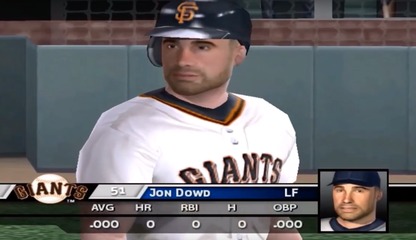
In 2003, Bonds withdrew from the MLB Players Association (MLBPA) licensing agreement, believing independent marketing deals would be more lucrative. He was the first player in the program's 30-year history not to sign. As a result, his name and likeness could not be used in MLBPA-licensed merchandise, forcing companies to deal directly with him. This led to his absence from many baseball video games, where game developers created generic athletes, like "Jon Dowd" in MVP Baseball 2005, as replacements, often altering their race or handedness to avoid likeness lawsuits.
The book Game of Shadows, written by Lance Williams and Mark Fainaru-Wada, was released in March 2006, sparking significant media attention. The book, which contained excerpts of Bonds's grand jury testimony (supposedly sealed), alleged that Bonds had used a variety of performance-enhancing drugs, including stanozolol, "the Clear" (THG), "the Cream," HGH, nandrolone, and insulin for at least five years starting in 1999. The authors refused to divulge their sources and faced potential jail time, but in February 2007, Troy Ellerman, a lawyer for BALCO founder Victor Conte, pleaded guilty to leaking the testimony. This book significantly influenced public opinion regarding Bonds's steroid use.
In May 2006, former Sports Illustrated writer Jeff Pearlman published Love Me, Hate Me: Barry Bonds and the Making of an Anti-Hero. This biography, based on over 500 interviews (none with Bonds himself), depicted Bonds as a polarizing, insufferable braggart with an outsized ego, further contributing to the negative perception of his character.
In April and May 2006, ESPN aired Bonds on Bonds, a 10-part reality TV series starring Bonds. The show focused on his pursuit of Babe Ruth's and Hank Aaron's home run records. Some critics called for the show to be put on hiatus until steroid allegations were investigated. The series was ultimately canceled in June 2006, with ESPN citing "creative control" issues with Bonds and his representatives.
5. Personal Life
5.1. Marriages and Family
Bonds met Susann ("Sun") Margreth Branco, a Canadian, in Montreal in August 1987. They eloped to Las Vegas on February 5, 1988, and had two children, Nikolai and Shikari. The couple separated in June 1994, divorced in December 1994, and their marriage was later annulled by the Catholic Church in 1997. Their divorce became a media spectacle, particularly due to a prenuptial agreement in which Sun waived her rights to his current and future earnings. The agreement was upheld by the Supreme Court of California in August 2000, leading to significant changes in California law regarding the validity and enforceability of premarital agreements. During the hearings, allegations of abuse were made by both parties. At the time of the ruling, Bonds was providing $20.00 K USD per month in child support and $10.00 K USD in spousal support.
In 2010, Bonds's son Nikolai, who had served as a Giants batboy during his father's playing years, was charged with five misdemeanors following a confrontation with his mother, Sun Bonds, who obtained a restraining order against him.
From 1994 to May 2003, Bonds was also involved in a relationship with Kimberly Bell, a graphic designer. Bonds reportedly purchased a home in Scottsdale, Arizona, for Bell.
On January 10, 1998, Bonds married his second wife, Liz Watson, at the San Francisco Ritz-Carlton Hotel. They lived in Los Altos Hills, California, with their daughter Aisha. After ten and a half years of marriage, Watson filed for legal separation on June 9, 2009, citing irreconcilable differences. Although she withdrew the action six weeks later, the couple reconciled for only seven months before Watson formally filed for divorce in Los Angeles on February 26, 2010. On June 6, 2011, Bonds and Watson filed a legal agreement to settle the divorce privately without further court involvement.
Several of Bonds's family members have been involved in athletics. His younger brother, Bobby Bonds Jr., also played professional baseball. His paternal aunt, Rosie Bonds, was a former American record holder in the 80 meter hurdles and competed in the 1964 Olympics. Bonds is also a distant cousin of Hall of Famer Reggie Jackson.
5.2. Other Interests and Activities
Among Bonds's many real estate properties is a home he owns in the exclusive gated community of Beverly Park in Beverly Hills, California. Bonds is an avid cyclist, choosing the activity as a primary means of staying in shape and a great passion since his playing career. Due to knee, back, and hip surgeries, running became difficult, but cycling allowed him to maintain cardiovascular fitness. As a result, he has lost 25 lb (25 lb) from his final playing weight of 240 lb (240 lb). Bonds is also an active practitioner of Brazilian jiu-jitsu and was promoted to blue belt in the martial art in 2023.
6. Legacy and Impact
Barry Bonds's legacy in baseball is complex and often divisive, defined by his unparalleled on-field achievements juxtaposed with the significant controversies surrounding his alleged use of performance-enhancing drugs.
6.1. Career Achievements and Records Overview
Bonds holds numerous MLB records, solidifying his place as one of the most dominant offensive players in history. He holds the career home run record (762), the single-season home run record (73 in 2001), and records for most career walks (2,558) and intentional walks (688). He also holds the single-season records for walks (232 in 2004) and intentional walks (120 in 2004). His 2001 single-season slugging percentage (.863) and 2004 single-season on-base percentage (.609) and OPS (1.422) are also MLB records.
At the time of his retirement, Bonds led all active players in RBI (1,996), on-base percentage (.444), runs (2,227), games (2,986), extra-base hits (1,440), at-bats per home run (12.92), and total bases (5,976). He ranks second all-time in doubles (601), slugging percentage (.607), and stolen bases (514). He is the only player in MLB history to be a member of the 500 home run/500 stolen base club, and he remains the sole member of the 400 home run/400 stolen base club. Bonds is also one of only six players all-time to be in the 40-40 club, hitting 40 home runs (42) and stealing 40 bases (40) in the same season (1996). He shares the record for most seasons with 30 home runs and 30 stolen bases (5) with his father, Bobby Bonds, making them the only father-son members of the 30-30 club.
Bonds received a record seven MVP awards, including an unprecedented four consecutive MVPs from 2001 to 2004. He earned 12 Silver Slugger Awards and eight Gold Glove Awards for his defensive play. He won two National League batting titles (2002, 2004), becoming the oldest player to win one for the first time at 38 years old. His numerous other distinctions include 13 National League Player of the Month selections and multiple "Player of the Year" awards from various publications such as Baseball America and The Sporting News. In 2005, The Sporting News ranked him sixth on their list of the 100 Greatest Baseball Players, the highest-ranked active player at the time.
In 2004, Bonds became the first player in history to have more times on base (376) than official at-bats (373), largely due to his record-setting number of walks. He also led all father-son combinations in combined home runs (1,094) and stolen bases (975) with his father, Bobby Bonds.
6.2. Enduring Influence and Reception
Bonds's enduring influence on baseball is undeniable, but his career is assessed through a complex lens, largely due to his association with the steroid era. While his on-field performance was historically dominant, his public perception often reflected skepticism and disdain from fans and media, particularly as he approached and broke major home run records. Away stadiums often featured signs mocking him with asterisks or syringe imagery, and chants like "Babe Ruth did it on hot dogs and beer. Hank Aaron did it with class. How did you do it?" were common.
Paradoxically, active players often held a different view. A 2007 USA Today poll found that 72% of active major leaguers considered Bonds the greatest home run hitter ever, compared to only 8% of fans. Players like David Ortiz, Barry Zito, and Tom Glavine often defended Bonds, suggesting that steroids alone could not account for his unique hitting prowess, highlighting his exceptional vision and timing. Some argued that Bonds had already achieved Hall of Fame-worthy statistics before his alleged steroid use began around 1999, and that the widespread prevalence of doping at a time when it was not explicitly prohibited by MLB rules made clear distinctions impossible.
The low television ratings for his record-breaking 756th home run game (1.1%) underscored the prevailing public indifference or coldness. Commissioner Bud Selig's hesitant response to Bonds's pursuit of records, including his absence from the record-breaking game, further reflected the uncomfortable position MLB found itself in. The controversy also sparked debates about the validity of other records, with some suggesting Roger Maris's 61 home runs should remain the true single-season record.
In popular culture, Chicago rapper Kanye West recorded a song titled "Barry Bonds" for his 2007 album Graduation, reflecting Bonds's larger-than-life status. Bonds's "Splash Hits" into McCovey Cove outside AT&T Park (35 all-time, significantly more than any other player) became a signature element of his home games, with fans often gathering in canoes and even wetsuits to retrieve his home run balls.
Ultimately, Barry Bonds's legacy remains a subject of intense debate, embodying the triumphs and complexities of baseball's modern era. His unparalleled statistics and revolutionary offensive approach secure his place as one of the sport's all-time greats, while the lingering questions and societal impact of the steroid era ensure his career continues to be a point of contentious discussion.